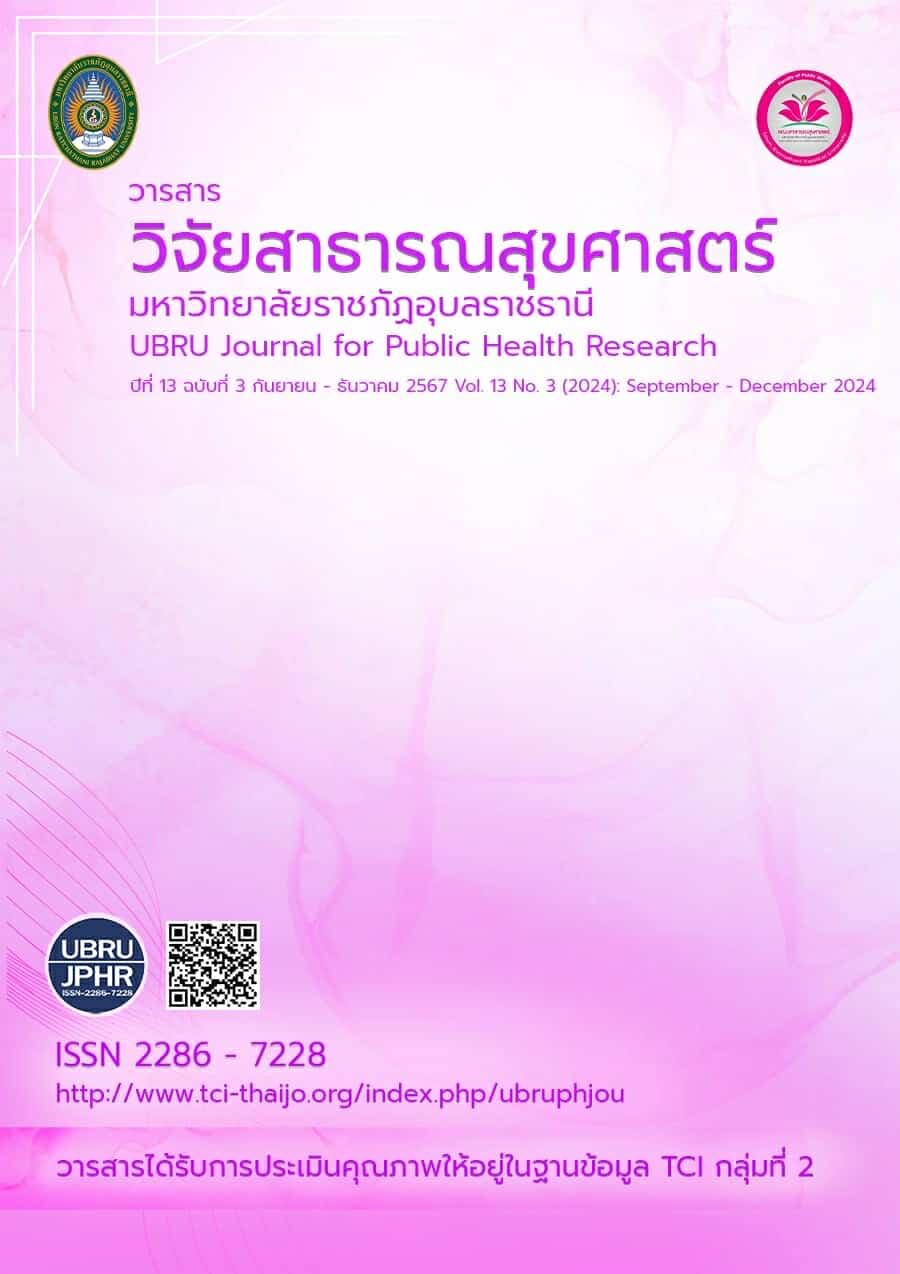A study of polar compounds in cooking oils used meat, eggs, flour and vegetables
Keywords:
Polar compound, used cooking oils, Fried foodAbstract
Fried food is very popular. However, consuming fried food poses health risks due to the formation of toxic compounds such as acrylamide and PAHs (Polycyclic Aromatic Hydrocarbons) in deteriorated frying oils. Polymeric substances in oils, such as free fatty acids, phospholipids, and oxidation products, significantly impact the stability, quality, and efficiency of various oil-based products. This study aims to determine the percentage of polymeric substances in commonly used cooking oils (palm oil, soybean oil, coconut oil, and olive oil) derived from fried meat, eggs, flour, and vegetables using Total Polar Compounds in the test set of reused cooking oils from the Department of Medical Sciences. Samples were randomly selected from Bangkok and Khon Kaen, totaling 47 samples. The analysis of 47 cooking oil samples revealed the following: Palm oil (27 samples) had 11.11% of good quality, 74.07% close to deteriorating, and 14.81% deteriorated. Soybean oil (11 samples) had 27.27% of good quality, 54.54% close to deteriorating, and 18.18% deteriorated. Coconut oil (4 samples) showed 100% close to deteriorating. Sesame oil (5 samples) had 20% of good quality, 60% cloe to deteriorating, and 20% deteriorated. Overall, 14.89% of the samples were of good quality, 70.21% were close to deteriorating, and 14.89% were deteriorated. In summary, the study shows that a large majority (85.10%) of tested fried oil samples do not meet quality standards due to high levels of polymeric compounds. Palm and soybean oils especially contain significantly higher amounts of these substances compared to coconut oil, and olive oil, indicating potential health risks from their repeated use in frying.References
Committee prepares prevention plan and national cancer control, Department of Medical Services, Ministry of Public Health of Thailand. (2018). National Cancer Control Program (2018-2022). Nonthaburi: Department of Medical Services, Ministry of Public Health of Thailand. (in Thai).
De Alzaa, F., Guillaume, C., Ravetti, L. (2018). Evaluation of Chemical and Physical Changes in Different Commercial Oils during Heating. Acta Scientific Nutritional Health, 2(6), 2-11.
Houhoula, D.P., Oreopoulou, V., & Tzia, C. (2003). The effect of process time and temperature on the accumulation of polar compounds in cottonseed oil during deep-fat frying. J. Sci. Food Agric., 83, 314-319.
Inprasit K, Mongkonchart P. (2014). Interesting information: Consumption of fried food that uses repeated frying oil. Bangkok: Community Technology Division, Department of Science Service. (in Thai)
Kittiwongsunthorn, W., Sriwiriyanupap W., Nartnampong, A., Phonrat, S., Mujarin, K., editor. (2014). Revolutionizing frying oil again from the pan to the national agenda. Bangkok: Health consumer Protection Project, Faculty of Pharmaceutical Sciences Chulalongkorn University. (in Thai)
Koh, S.P., & Long, K. (2012). Oxidative stability study of virgin coconut oil during deep frying. J. Trop. Agric. and Fd. Sc., 40(1), 35– 44
Metayer, C., Wang, Z., Kleinerman, R.A., Wang, L., Brenner, A.V., Cui, H., et al. (2002). Cooking oil fumes and risk of lung cancer in women in rural Gansu, China. Lung Cancer., 35(2), 111-117
Ministry of Public Health (Thailand). (n.d.). Test Kit for Total Polar Compounds in Repeatedly Used Cooking Oil. Nonthaburi: Ministry of Public Health
Nartnampong A, Bunnim D, Rakkaen W, Sriwan K. (2008). Revolutionizing frying oil by testing kit. Bangkok: Health Consumer Protection Program, Faculty of Pharmaceutical Sciences, Chulalongkorn University. ( in Thai)
Ng, C.Y., Kamisah, Y., Faizah, O., Jaarin, K. (2012). The role of repeatedly heated soybean oil in the development of hypertension in rats: association with vascular inflammation. Int J Exp Pathol., 93(5), 377-87).
Ounhalekjit P. (2016). A study of time period relationship afterward polar compound formation in cooking oils used meat and flour. The 3rd National Academic Conference and Presentation of Research Results, Moving Forward to the 2nd Century: Integrating Research, Using Knowledge, and Sustainability. Nakhon Ratchasima: Nakhon Ratchasima College
Pooja, C. & Sukhneet, S. (2021). Polar Compounds in Frying Oils: A Review. Applied Ecology and Environmental Sciences. 2021, 9(1), 21-29. DOI: 10.12691/aees-9-1-3
Rassmeepakorn T, Tonin N, Saetia, S., Tangsurakit, T., Nakkhaiw, C., Limpornchaicharoen, N., et al. (2023). Perception of fried foods and consumption behavior among Thai people aged 18-60 years old. Institute for Urban Disease Control and Prevention Journal, 8(2): 161-177.
Soriguer, F., Rojo-Martínez, G., Dobarganes, M.C., García Almeida, J.M., Esteva, I., Beltrán, M., et al. (2003). Hypertension is related to the degradation of dietary frying oils. Int J American Society for Clinical Nutrition, 78 (7), 1097-1092
Szabo, Z. Marosvölgyi, T., Szabo, E., Koczka, V., Verzar, Z., Figler, Maria. and Decsi T. Effects of Repeated Heating on Fatty Acid Composition of Plant-Based Cooking Oils. Foods. 11(2): 192. doi: 10.3390/foods11020192.
Xu, X.Q. (2000). A new spectroscopic method for the rapid assessment of deep-frying oil quality. Journal of the American Oil Chemists' Society, 77(10), 1083-1086.
Zhang, J., Chen, X., Yang, R., Ma, Q., Qi, W., Sanidad, K.Z., et al. (2019). Thermally Processed Oil Exaggerates Colonic Inflammation and Colitis-Associated Colon Tumorigenesis in Mice. Cancer Prev Res (Phila)., 12(11), 741-750.
Downloads
Published
How to Cite
Issue
Section
License
Copyright (c) 2024 คณะสาธารณสุขศาสตร์ มหาวิทยาลัยราชภัฏอุบลราชธานี

This work is licensed under a Creative Commons Attribution-NonCommercial-NoDerivatives 4.0 International License.
เนื้อหาและข้อมูลในบทความที่ลงตีพิมพ์ในวารสารวารสารวิจัยสาธารณสุขศาสตร์ มหาวิทยาลัยราชภัฏอุบลราชธานี ถือเป็นข้อคิดเห็นและความรับผิดชอบของผู้เขียนบทความโดยตรงซึ่งกองบรรณาธิการวารสาร ไม่จำเป็นต้องเห็นด้วย หรือร่วมรับผิดชอบใดๆ
บทความ ข้อมูล เนื้อหา รูปภาพ ฯลฯ ที่ได้รับการตีพิมพ์ในวารสารนี้ ถือเป็นลิขสิทธิ์ของวารสารฯ หากบุคคลหรือหน่วยงานใดต้องการนำทั้งหมดหรือส่วนหนึ่งส่วนใดไปเผยแพร่ต่อหรือเพื่อกระทำการใดๆ จะต้องได้รับอนุญาตเป็นลายลักอักษรณ์จากบรรณาธิการวารสารนี้ก่อนเท่านั้น


